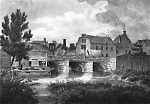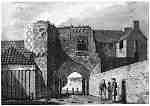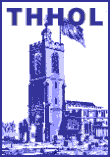This Parish is bounded on the east by the river Lea, which forms in this direction a line of separation between Middlesex and Essex; on the north and north west it meets Hackney and Bethnal Green; on the west and south-west it is bounded by the extensive parish of Stepney, of which it once formed a part; and on the south-east it abuts on the parish of St. Leonard Bromley. This district contains about 465 acres of land, of which 218 are arable ; the remainder are meadow, pasture, and marsh-land, except about 24 acres occupied as nursery-grounds and market-gardens. The parish was separated from that of Stepney in the year 1730, and includes Old Ford as a hamlet.
The village of Stratford Bow is situated about two miles from London, on the Essex road. The term Stratford evidently alludes to an ancient ford communicating with one of the Roman highways. The addition of Bow is derived from a bridge of one arch, which was thrown over the river Lea in the reign of Henry I. From that period the place was distinguished by the adjunct atte boghe, atte boughe or at the bow. The word Stratford has long been dropped in familiar usage, and the village is now known by the term originally bestowed on it only for the purpose of distinction.
 Concerning
the Bridge which forms so important a feature in the annals of this parish, an historical
account, of some length, has been given by Leland in his Collectanea, and by Stowe. But the
following statement, inserted in the 'Environs of London,' is the most desirable document, as
the substance of it was given in, upon oath, at an inquisition taken before two persons, the
King's Justices, in the year 1303.
Concerning
the Bridge which forms so important a feature in the annals of this parish, an historical
account, of some length, has been given by Leland in his Collectanea, and by Stowe. But the
following statement, inserted in the 'Environs of London,' is the most desirable document, as
the substance of it was given in, upon oath, at an inquisition taken before two persons, the
King's Justices, in the year 1303.
'The jurors declared, that at the time when Matilda, the good Queen of England, lived, the road from London to Essex was by a place called the Old Ford, where there was no bridge, and during great inundations, was so extremely dangerous, that many passengers lost their lives; which coming to, the good Queen's ears, she caused the road to be turned where it now is, namely between the towns of Stratford and Westham; and of her bounty caused the bridges and road to be made, except the bridge called Chaner's Bridge, which ought to be made by the Abbot of Stratford. They said further, that Hugh Pratt, living near the roads and bridges in the reign of King John, did of his own authority, begging the aid of passengers, keep them in repair. After his death, his son William did the same for some time, and afterwards, through the interest of Robert Passelewe, the King's Justice, obtained a toll, which enabled him to make an iron railing upon a certain bridge, called Lockbridge, from which circumstance he altered his name from Pratt to Bridgwryght ; and thus were the bridges repaired till Philip Basset and the abbot of Waltham being hindered from passing that way with their waggons in the late reign, broke down the railing, whereby the said William, being no longer able to repair it, left the bridge in ruins, in which state it remained, till Queen Eleanor of her bounty ordered it to be repaired, committing the charge of it to William de Capella, keeper of her chapel. Alter which one William de Carlton, yet living, repaired all the bridges with the effects of Bartholomew de Castello, deceased. The jurors added, that the bridges and roads had been always repaired by bounties, and that there were no lands or tenements charged with their repair, except for Chaner's Bridge, which the abbot of Stratford was bound to keep in repair.'
Bow Bridge now consists of three arches, and bears marks of considerable antiquity ; but the numerous alterations and repairs which have taken place in different centuries, leave it doubtful whether any part of the original fabric is still re maining.
 The
village of Bow wears the aspect of a small, though busy, country-town. It would appear that
this neighbourhood was of some note, in the 14th century, for affording instruction in the French
Ianguage. Chaucer, in a prologue to the Canterbury Tales, thus mentions the village:
The
village of Bow wears the aspect of a small, though busy, country-town. It would appear that
this neighbourhood was of some note, in the 14th century, for affording instruction in the French
Ianguage. Chaucer, in a prologue to the Canterbury Tales, thus mentions the village:
' - French she spake full fayre and fetisly,
After the scole of Stratford atte Bowe,
For French of Paris was to hire unknowe.'
In the year 1556, thirteen persons were here burned at the stake, for differing in religious opinions from the existing government.
When Don Antonio Perez, Prior of Crato, who endeavoured to obtain the crown of Portugal, in opposition to Philip II of Spain, fled to England for refuge, he was permitted to retire to this village, where he resided while negotiating with Queen Elizabeth for aid in support of his pretensions. In the parish register is an entry of the burial of a person, there styled his treasurer.
The Church of Stratford Bow was built as a chapel of ease to Stepney early in the 14th century, in consequence of a petition of the inhabitants of this place, and of Oldford, stating their inconvenient distance from the parish-church, and the difficulty of the roads, which were almost impassable in winter on account of floods. A license for the erecting of the chapel was granted by Bishop Baldock, in 1311, and the Chantry roll at the augmentation office says that 'it was founded by King Edward III on a piece of ground which was part of the King's Highway.' This chapel was consecrated, as a parish church, on the 26th of March, 1719. The benefice is a rectory, not to be held in commendam.
The original building yet remains, and has experienced few alterations. The chief parts of this structure are composed of stone and flint. At the western end is a tower, not embattled, and of rather low proportions, with graduated buttresses. At one corner of the tower rises an octangular turret.
The interior is divided into a chancel, a nave, and two aisles, which are separated from the nave by octagonal pillars supporting pointed arches. In the nave is the monument of Mrs. Prisca Coborne, who died in 1701, and who was an eminent benefactress to the parish.
At a small remove from the church, towards the east, is a building which appears to have been used as a market house, but we are not aware that this place ever obtained the legal grant of a market. A room over the open part of this building has long been occupied as a charity school, on the foundation of Sir John Jolles, established in 1613, and intended for 35 boys of Stratford Bow and St. Leonard Bromley. At a short distance, on the northern side of the street, is a mansion of some antiquity, now used as the parish workhouse. The ceiling and chimney-case of a large room in the first story are plentifully ornamented with stucco and carving, but neither possesses any armorial allusions.
Mrs. Prisca Coburne, who died in 1701, and whose monument we have noticed above, bequeathed a property of some extent, with a charitable intention. From the proceeds of this bequest the sum of 50l. per ann. was to be paid for the instruction of 50 poor children, and the remaining profits, if any such occurred, were to be used by the trustees according to their discretion. The property so bequeathed has very largely increased in value, but the poor have not, until lately, received benefit from the increase. So many charitable institutions are treated with abuse or neglect, that we shall not create surprise by saying that an estate, really worth several hundred pounds per annum,was long allowed to be merely equivalent to the payment of 50l. annually to the schoolmaster. The circumstances attending this charity have lately, however, been investigated, and the beneficent intention of the foundress, according to the spirit of her bequest, is now carried into execution. Commodious school-rooms with an attached house for the master (who is, at present, the curate of Stratford Bow) have been erected at the expense of nearly 2000l. The whole of the poor children of Bow are now permitted to receive instruction in this school, according to the system of Dr. Bell; and children from other parishes are likewise received, if properly recommended. The buildings are substantial, and well-adapted to their object.
There is, likewise, a school founded by Mrs. Meliora Priestley, in which eight girls are educated.
This parish contains meeting-houses for the Methodists and Baptists. A charity-school is attached to the latter congregation.
The principal establishments appertaining to manufactures are the vitriol works belonging to Messrs. Smith and Co. and one extensive ground for calico-printing. In the Magna Britannia it is said 'that at Stratford le bow most of the bread which was spent in the outparts, and nearest streets of the city of London, was baked, and carried thither daily in certain carts, called Bread-carts.'
 The
hamlet of OLD FORD is situated to the north of Bow, on the border of the river Lea. In this
place stood an ancient mansion, often termed King John's Palace, but which does not appear to
have been at any period vested in the crown. The site of this mansion was given to Christ's
Hospital by a citizen of London, named Williams in the year 1665. A brick gateway, which has
been recently covered with cement, is now the only relic of the ancient building. The present
lessee of the estate is Henry Manley, Esq. who has here a handsome residence, and has much improved
the grounds and neighbourhood.
The
hamlet of OLD FORD is situated to the north of Bow, on the border of the river Lea. In this
place stood an ancient mansion, often termed King John's Palace, but which does not appear to
have been at any period vested in the crown. The site of this mansion was given to Christ's
Hospital by a citizen of London, named Williams in the year 1665. A brick gateway, which has
been recently covered with cement, is now the only relic of the ancient building. The present
lessee of the estate is Henry Manley, Esq. who has here a handsome residence, and has much improved
the grounds and neighbourhood.
Near Oldford are the East London Waterworks, which were constructed in pursuance of an act of Parliament passed in 1807, for 'the purpose of better supplying with water the in habitants of Stratford Bow, Hackney, Bethnal-green,' and other adjacent parishes and hamlets. The proprietors have obtained a subsequent act, empowering them to purchase the Westham and the Shadwell water-works of the London Dock Company. Here are, also, the extensive dye-houses of Messrs Burchall and Co.
by J. Norris Brewer
